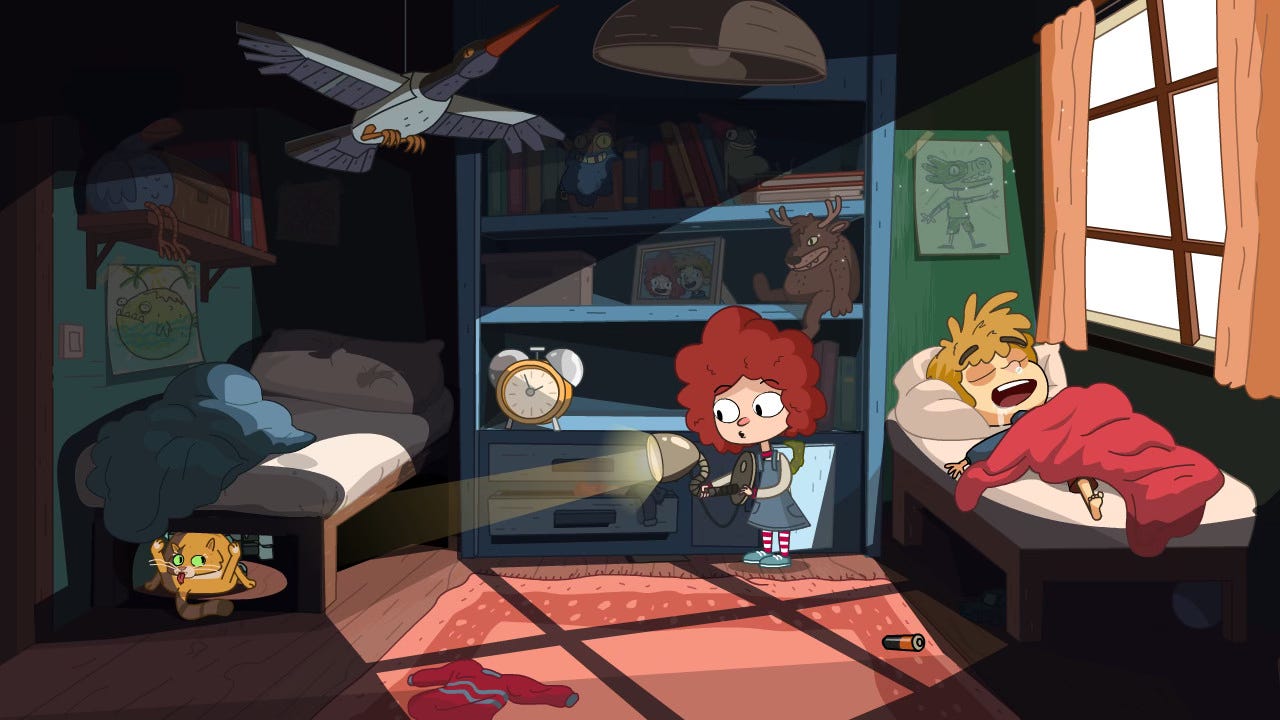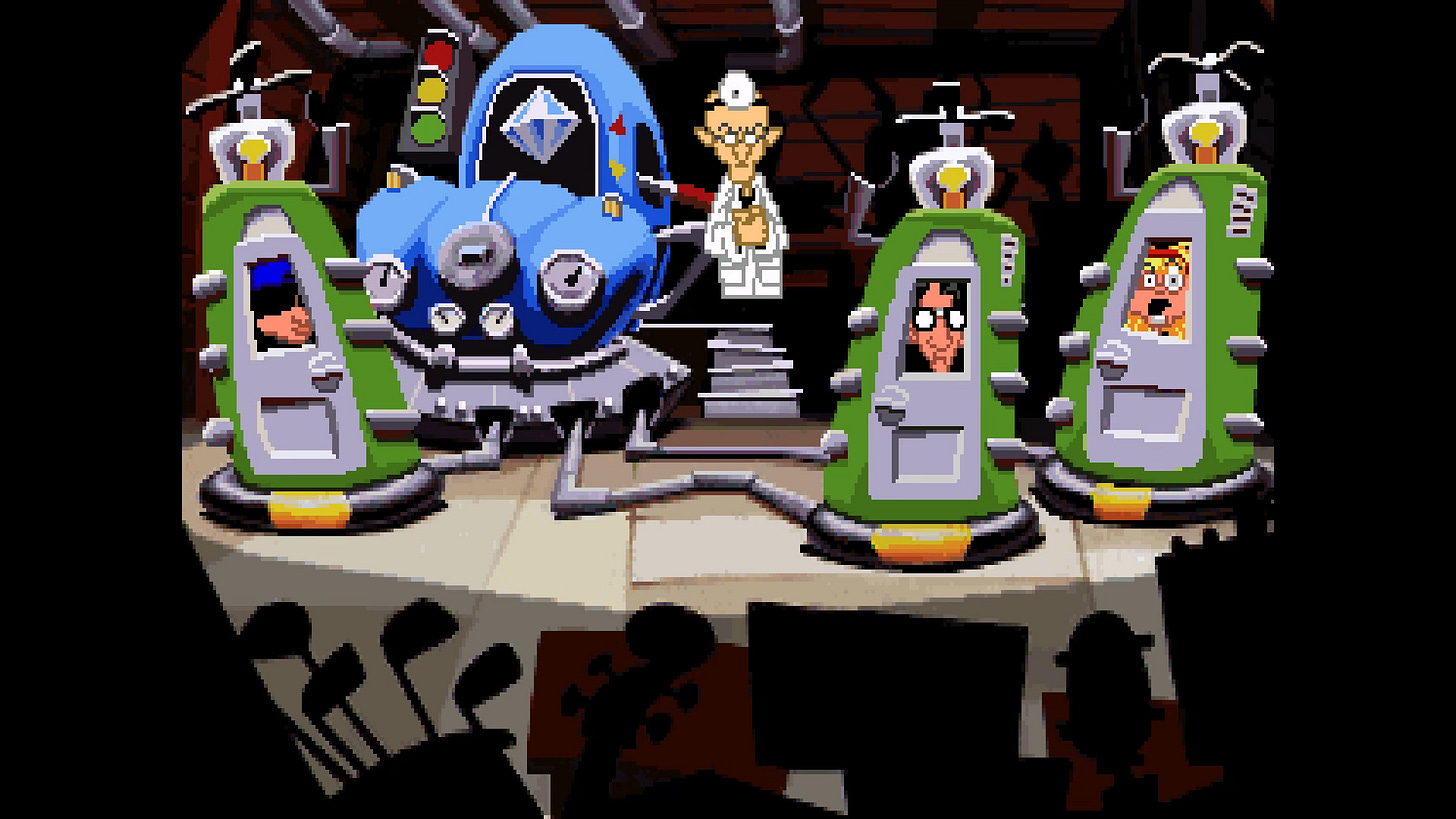Lost in Play Is a Modern Point-And-Click Adventure Game That's Perfect For Kids
A good hint system, no punishment for having trouble reading. It's fantastic.
I was eight years old when Sam & Max Hit the Road came out. The LucasArts point-and-click adventure game about two well-meaning but humorously clueless anthropomorphic cops made me laugh, think, scream, and the voice acting helped justify the family’s pricey CD-ROM drive. I quite liked Telltale’s sequel series, too.
32 years later, I would not subject my eight-year-old daughter to Sam & Max.
The puzzles are obtuse. There’s no real hint system. The games, even the best ones, felt like a pixel hunt. Time—and game design—marches ever on. But the core of the adventure game, a beautiful sense of discovery and bewilderment, remains enthralling.
I’ve heard a lot about Lost in Play, a story about the imagination of children as seen through the eyes of children, over the years. But it wasn’t until the game launched on Apple Arcade this month that I decided to sit down with my oldest daughter and give it a try. Like my old favorites, it’s absolutely gorgeous. And it is, by any definition, a point-and-click adventure game. You’re just using a finger to point and click now!
Note: Lost in Play is not exclusive to Apple Arcade. It’s available on almost every other platform, including PC, Google Play, PlayStation 4/5, and Switch. No Xbox, however.
An important difference is Lost in Play knows it’s a point-and-click adventure game released in 2025, being played people who might not know what a point-and-click game is. Many genres struggle to adapt as new audiences arrive, unaware of old tropes.
As such, Lost in Play has a simple but effective hint system that does everything but spell out what to do next. There’s no punishment or judgement for using it. “Everything but” is notable, because it means the child still feels the satisfaction of putting it together. (With more challenging puzzles, like one involving sliding blocks, it’s possible to skip the puzzle entirely. I was so delighted when my child refused to! But I also noticed she quickly started using the hint system as a crutch for progress.)
You, the adult, are not likely to feel challenged. But it’s not a pushover for the kid, either. It’s a wonderful balance between the two, the ultimate play-with-your-kid game, where they can reach their limits before you help them across the finish line.
We had a great time playing the first third of the game (it’s short), and my hope is we’ll return to it during a long road trip that’s coming up for the family this weekend.
I recently had a chance to ask Lost in Play designer and Happy Juice co-founder Yuval Markovich about puzzle design for families, making a game without text or dialogue, and what it was like for a fan of old school adventure games to make their own game.
Crossplay: What were some of your favorite games as kids? What drew you to them?
Yuval Markovich: As a kid, I loved all kinds of games, but I was especially drawn to the classic Sierra and LucasArts titles, games like Monkey Island, Day of the Tentacle, Space Quest, and Leisure Suit Larry. What drew me to these kinds of games was the feeling of being immersed in a world where I could interact with quirky characters and be part of the story. I still love solving puzzles to this day, and those games were full of them—though some were definitely too difficult for me back then. On top of that, their amazing aesthetics were groundbreaking for their time, and most of all, they had a great sense of humor.
I know Lost in Play proved popular amongst families, with parents and kids playing together. Did you anticipate this—and design for—the idea that it might be a game played together by families?
Markovich: Actually, that was very much by design. We love playing games with our children, and one of the main motivations behind Lost in Play was the lack of games we could truly enjoy together with our young kids. So many games rely heavily on fear or violence as their core hook or if they don’t, they often feature mechanics that, as an adult, I find boring. We wanted to create a game that evokes a broader range of emotions and offers gameplay that’s genuinely enjoyable for adults too. It’s similar to how I feel watching a Pixar film with my daughters, I’m not watching it just to please them; I genuinely love it, just as they do.
Puzzle design is tricky, especially when you’re targeting younger audiences. How did you go about tweaking what made a puzzle rewarding for different ages?
Markovich: Different players approach puzzles in very different ways, but I think children often have more stamina when it comes to failing repeatedly before finally succeeding. Maybe it’s because they don’t carry the same self-judgment that some adults do, thoughts like “I’m not good at games” or “I’m bad at puzzles. ” Or maybe it’s the sense of motivation they get from tackling a puzzle they know is challenging even for their parents.
Most puzzles offer a limited set of possibilities, and if you tinker with them long enough, you’ll eventually figure them out. A good puzzle doesn’t require you to be Einstein, it just needs to make you feel clever when you solve it.
We also included a hint system in the game that, as the name suggests, gently nudges players in the right direction without giving away the answer, even if you use a hint, you still get that sense of accomplishment when you solve it.
But above all, it comes down to playtesting and refining the puzzles again and again with different types of players.
Are you parents yourselves? If so, I’m curious to know what about your own parenting journeys found their way into designing Lost in Play.
Markovich: We are all parents and some of our children were even born during the production of the game.
The core idea of Lost in Play was actually originated from when Oren Rubin (co-founder of Happy Juice, animator, and designer) was watching his children play make-believe games
and get totally immersed in their own world and he started to think about making a game that will try to convey that feeling of playing a game with your sibling in an imaginary world
you share, a feeling a lot of us had as children and lost as adults. I immediately connected with this feeling, remembering my time of playing with my older sister. Toto and Gal, the protagonists of Lost in Play, are loosely inspired by Tomer and Tal, Oren's children.
“Different players approach puzzles in very different ways, but I think children often have more stamina when it comes to failing repeatedly before finally succeeding. Maybe it’s because they don’t carry the same self-judgment that some adults do, thoughts like ‘I’m not good at games’ or ‘I’m bad at puzzles.’ Or maybe it’s the sense of motivation they get from tackling a puzzle they know is challenging even for their parents.”
The game doesn’t feature any dialogue. Can you talk about that choice? This is an aside, but one of my annoyances with a lot of “family friendly” video games is the amount of writing. My eight-year-old, when she was younger, would get frustrated at games she could mechanically play but not actually enjoy because the writing was taxing her so much.
Markovich: There are several reasons for this, but above all, it comes down to our personal taste as players.
I remember playing old adventure games and often feeling frustrated because English wasn’t my first language. As a child, I found it difficult to follow the dialogue. I actually ended up learning English by sitting with a dictionary, trying to understand what everyone was saying. Even today, I’m not a fan of dialogue-heavy mechanics or reading large amounts of text in games. I much prefer when stories are told visually and through actions rather than words.
This approach had several benefits for players. For one, even those who can’t read or don’t speak one of the game’s localized languages can still understand the story and puzzles, since everything is communicated visually. It also meant we only had to localize the menus, which allowed us to support 30 languages, making the game much more accessible and appealing to a global audience. And players really do care about experiencing a game in their own language.
Fun fact: the voice actors who created the game’s gibberish language are Jonathan and Eliana Magon, a pair of siblings making them a perfect fit for Lost in Play.
Have a story idea? Want to share a tip? Got a funny parenting story? Drop Patrick an email.
Also:
When I saw my daughter overly relying on the hint system, we would pause for a moment, talk though our options, and she’d often come up with the solution. (To the game’s credit, the hint system “loads” the hint, almost as if it wants the player to re-consider their decision to ask for help, even if ultimately it doesn’t stop you.)
During a sliding block puzzle, my daughter was flummoxed but kept coming up with new solutions for the problem. Eventually, we worked together, I saw the solution in sight, and told her to work through the solution in her brain before moving the pieces. She was quiet for a moment before her eyes lit up brightly.
The lack of dialogue (or text) is interesting, because it means the has to entirely rely on its visuals to communicate not only its emotions, but its puzzles, too.





Really enjoying this game with my 6 year old. It’s making me wish we had versions of Gizmos and Gadgets / Treasure Math Storm on iPad.
Amazing to see more about this game. My daughter also loved it. She was able to get through much of it on her own before she had figured out reading.